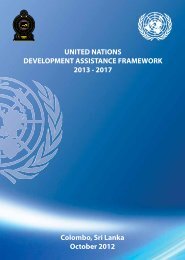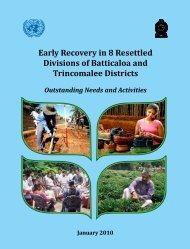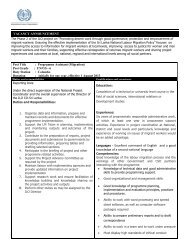Sri Lanka Human Development Report 2012.pdf
Sri Lanka Human Development Report 2012.pdf
Sri Lanka Human Development Report 2012.pdf
Create successful ePaper yourself
Turn your PDF publications into a flip-book with our unique Google optimized e-Paper software.
Many problems and inequities are graver in conflictaffected<br />
areas, where several hundred thousand families<br />
have been displaced from their homes, and children have<br />
been forced to leave schools. Many have been exposed to<br />
violence, lost family members, become disabled, lived for<br />
extended periods in welfare centres, and suffered physical<br />
and emotional traumas. Education facilities have been<br />
damaged, repairs and maintenance have not kept pace,<br />
and teacher shortages continue unabated. 159<br />
With the end of the conflict, government education<br />
authorities at all levels, with support from the United<br />
Nations and other local and international agencies, have<br />
worked to uphold children’s right to education in conflictaffected<br />
areas. Almost all schools have reopened, and a<br />
recent census in the Northern Province found that 90.9<br />
percent of children required to go to school were now<br />
doing so. 160 The quality of education is still an issue; it will<br />
take time to resolve. In conflict affected areas, UNICEF<br />
Box 4.1<br />
The Education Sector <strong>Development</strong> Framework and Programme 2006-2010<br />
The Education Sector <strong>Development</strong> Framework and<br />
Programme strategy was developed on the basis of a sectorwide<br />
approach. 162 It paves the way for sustained development<br />
of the sector by mainstreaming and coordinating external<br />
donor investments with government budgeting at the central,<br />
provincial and school levels. Bottom-up planning gives a<br />
greater focus to the needs of schools.<br />
Key initiatives and achievements under different dimensions<br />
of the programme include:<br />
Promote equitable access to basic education (grades 1-9)<br />
and secondary education (grades 10-13).<br />
• Provision of school meals to primary school children in<br />
poor areas: In 2008, the programme covered 6,024<br />
schools, benefitting 575,745 children. The extension of<br />
school feeding activities to primary grades in the Northern<br />
and Eastern provinces started in 2009.<br />
• Delivery of special education programmes for children with<br />
special learning needs.<br />
• Non-formal education programs for non-school-going<br />
children and adolescents included surveying and identifying<br />
non-school-going children, providing facilities and training<br />
staff.<br />
• The number of out-of-school children declined by<br />
approximately 68,000 against the target of 50,000 (a<br />
146 percent achievement).<br />
• The passage of students through the compulsory basic<br />
education cycle continuously improved from 78 percent<br />
in 2005 to 91 percent in 2010, against the programme<br />
target of 88 percent.<br />
Improve the quality of education.<br />
• Child-centered pedagogical methods were promoted. Both<br />
curricula and teacher instructional manuals were revised<br />
and updated for all grades.<br />
• 110,501 in-service advisors were trained to help teachers<br />
by providing practical guidance on pedagogy.<br />
• There were significant improvements in the national<br />
assessment of grade four students.<br />
Enhance the economic efficiency and equity of resource<br />
allocation and distribution within the education system.<br />
• A medium-term budget framework was developed for<br />
basic and secondary education.<br />
• The Public Expenditure and Quality Education Tracking<br />
System has been established to promote equity and<br />
transparency in resource distribution. It tracks the flow<br />
of expenditures to, and through, the various levels of the<br />
central and provincial education system down to schools.<br />
Theme 4: Strengthen education governance and service<br />
delivery.<br />
• The Government introduced a balanced-control model of<br />
school-based management.<br />
• Local communities, parents and guardians are able to<br />
participate in school management and make the delivery<br />
of school services more sensitive to the needs of local<br />
children.<br />
Source: Ministry of Education 2007, Aturupane 2009 and<br />
The World Bank 2011b.<br />
Chapter 4 Bridging <strong>Human</strong> <strong>Development</strong> Gaps: EDUCATION 69






